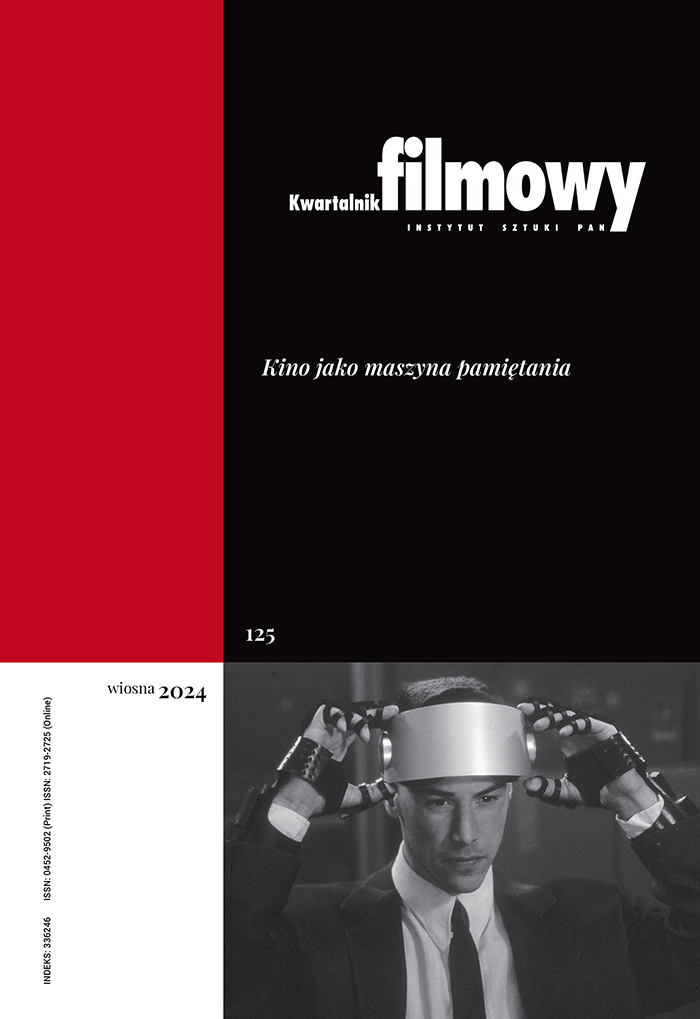Behind the Screen of Nostalgia: Working with/through Trauma in Ilya Khrzhanovsky’s “DAU” Project
Paulina Gorlewska
paulina.gorlewska@gmail.comJagiellonian University (Poland)
https://orcid.org/0000-0003-3892-2644
Abstract
The article examines the controversial multidisciplinary project DAU by Ilya Khrzhanovsky. The analysis of the content, production, and reception of its individual parts is set against the backdrop of criticism directed at the project, accusing the creators of DAU of on-set abuse (especially exploiting actresses) and unethical filmmaking practices. The article proposes the hypothesis that the guiding principle of DAU is Freud’s Nachträglichkeit (deferred action), a key concept in psychoanalytic theory used to explain the formation and functioning of trauma, as well as the process of healing. The example of Russian society demonstrates how terror and the collapse of the USSR function as the first and second traumatic blows. The failure to fully process the past results in nostalgia, which acts as a screen memory that conceals the traumatic source of suffering. By materializing the fantasies of restorative nostalgia through the reconstruction of an oppressive reality, DAU retroactively marks the Soviet past, revealing its traumatic core. The project forces viewers to confront the violence that is an integral part of Russian culture.
Keywords:
trauma in film, Nachträglichkeit, restorative nostalgia, Ilya KhrzhanovskyReferences
Aronson, O., Barbour, A., Bryukhovetska, O., Cavendish, P., Drubek, N. i in. (2020). DAU: „Sometimes This Space Can Hurt You”. Apparatus. Film, Media and Digital Cultures in Central and Eastern Europe, (10). http://doi.org/10.17892/app.2020.00010.230
Google Scholar
Bird, R. (2019, 12 marca). Ilya Khrzhanovsky’s „DAU”. e-flux. https://www.e-flux.com/ criticism/256823/ilya-khrzhanovsky-s-dau
Google Scholar
Bistoen, G., Vanheule, S., Craps, S. (2014). „Nachträglichkeit”: A Freudian Perspective on Delayed Traumatic Reactions. Theory and Psychology, 24 (5), ss. 668-687. https:// doi.org/10.1177/095935431453
DOI: https://doi.org/10.1177/0959354314530812
Google Scholar
Bohomolec, E. (2013). Czas w psychoanalizie. Psychoanaliza.org.pl. http://psychoanaliza.org.pl/czas-w-psychoanalizie-2
Google Scholar
Boym, S. (2001). The Future of Nostalgia. New York: Basic Books.
Google Scholar
Cavendish, P., Chukhrov, K., Dragaeva, S., Ezerova, D., Kostylyeva, E. i in. (2022). Soviet Playtime: Architectures of Power and Profligacy in DAU (red. P. Cavendish, N. Drubek, I. Schulzki). Apparatus. Film, Media and Digital Cultures in Central and Eastern Europe, (14). https://doi.org/10.17892/app.2022.00014.298
Google Scholar
Eisenstein, S. (1964). Izobrannyje proizwiedienija (t. 6). Moskwa: Iskusstwo.
Google Scholar
Ezerova, D. (2022). Watching the Unwatchable: DAU. Apparatus. Film, Media and Digital Cultures in Central and Eastern Europe, (14). https://doi.org/10.17892/ app.2022.00014.298
Google Scholar
Felman, S., Laub, D. (1992). Testimony: Crises of Witnessing in Literature, Psychoanalysis, and History. New York: Routledge.
Google Scholar
Garland, C. (2013). Działanie, identyfikacja i myśl w stanach posttraumatycznych (tłum. A. Rokujżo). W: C. Garland (red.), Czym jest trauma. Podejście psychoanalityczne (ss. 211-226). Warszawa: Oficyna Ingenium.
Google Scholar
Gutiérrez-Peláez, M. (2009). Trauma Theory in Sándor Ferenczi’s Writings of 1931 and 1932. The International Journal of Psychoanalysis, 90 (6), ss. 1217-1233. https://doi. org/10.1111/j.1745-8315.2009.00190.x
DOI: https://doi.org/10.1111/j.1745-8315.2009.00190.x
Google Scholar
Hook, D. (2012). Screened History: Nostalgia as Defensive Formation. Peace and Conflict: Journal of Peace Psychology, 18 (3), ss. 225-239. https://doi.org/10.1037/a0029071
DOI: https://doi.org/10.1037/a0029071
Google Scholar
Jampolskij, M. (2019). Ekscies, isterija, razruszienije. Chapaev.media. https://chapaev. media/articles/11010
Google Scholar
Jampolskij, M. (2019). Mietod „DAU”. Seanse, (70), ss. 29-49.
Google Scholar
Kaledin, D. (2020, 8 marca). „Dau” F.A.Q.. Imperium.lenin.ru. http://imperium.lenin. ru/~kaledin/dau-faq.html
Google Scholar
Kaszyn, O. (2010). Put „Dau”. Kommiersant Wlast, (37), s. 24.
Google Scholar
Kirchhoff, C. (2023). „Atak teraźniejszości na resztę czasu”. Naznaczenie wsteczne między kliniką a kulturą (tłum. K. Domaradzka). wunderblock, 3, ss. 2-17. https://doi. org/10.37240/ wb.2023.3.1
DOI: https://doi.org/10.37240/2023.3.1
Google Scholar
Lipszyc, A. (2022). Freud: Logika doświadczenia. Spekulacja marańskie. Warszawa: Instytut Badań Literackich PAN.
Google Scholar
Makarova, E. (2022). Soviet, Sacred, Sexual: The Carnivalised Architecture in Khrzhanovskiy’s „DAU”. Apparatus. Film, Media and Digital Cultures in Central and Eastern Europe, (14), ss. 153-168. http://doi.org/10.17892/app.2022.00014.308
Google Scholar
Morley, R. (2022). „The Grinding of Sand on Tiles…”: Forms of Female Subjectivity in „DAU. Katya Tanya”. Apparatus. Film, Media and Digital Cultures in Central and Eastern Europe, (14), ss. 83-132. http://doi.org/10.17892/app.2022.00014.293
Google Scholar
Saprykin, J. (2019, 23 stycznia). „DAU”. Tiomnyje naczała. Seanse. https://seance.ru/ articles/dau-saprykin
Google Scholar
Schulzki, I. (2022). „DAU”. Aljona Zoja. Interwju s asistientkami reżisjora Jelenoj Bogman i Zojei Popowoj. Apparatus. Film, Media and Digital Cultures in Central and Eastern Europe, (14). http://doi.org/10.17892/app.2022.00014.300
Google Scholar
Stubley, J. (2024). Trauma złożona: model Tavistock. Etapowe i wielomodalnościowe podejście terapeutyczne utrzymane w ramach psychoanalizy (tłum. W. Turopolski). W: P. Biernacki (red.), Leczenie traumy złożonej. Modyfikacje technik pracy. Kraków: Fundacja im. Boguchwała Winida na Rzecz Rozwoju Psychoterapii Psychoanalitycznej.
Google Scholar
Williams, L. (2010). Władza, przyjemność i „logika widzialności” (tłum. J. Burzyńska, I. Hansz, M. Wojtyna). Gdańsk: słowo/obraz terytoria.
Google Scholar
Zaezjev, A. (2022). „Gesamtkunstwerk” Khrzhanovskiy?. Projekt DAU i nasledije moskowskowo konceptualizma. Apparatus. Film, Media and Digital Cultures in Central and Eastern Europe, (14). https://doi.org/10.17892/app.2022.00014.309
Google Scholar
Zvonkine, E., Valssov, A. (2022). „DAU Is a Process”: A Conversation with Director Ilya Khrzhanovskiy. Apparatus. Film, Media and Digital Cultures in Central and Eastern Europe, (14). http://doi.org/10.17892/app.2022.00014.299
Google Scholar
Authors
Paulina Gorlewskapaulina.gorlewska@gmail.com
Jagiellonian University Poland
https://orcid.org/0000-0003-3892-2644
She holds a PhD in Film Studies from the Jagiellonian University in Kraków. Her research areas are the history of Polish and Russian cinema, trauma studies, and memory studies.
Statistics
Abstract views: 66PDF downloads: 52
License
Copyright (c) 2025 Paulina Gorlewska

This work is licensed under a Creative Commons Attribution 4.0 International License.
The author grants the publisher a royalty-free non-exclusive licence (CC BY 4.0) to use the article in Kwartalnik Filmowy, retains full copyright, and agrees to identify the work as first having been published in Kwartalnik Filmowy should it be published or used again (download licence agreement). The journal is published under the CC BY 4.0 licence. By submitting an article, the author agrees to make it available under this licence.
In issues from 105-106 (2019) to 119 (2022) all articles were published under the CC BY-NC-ND 4.0 licence. During this period the authors granted a royalty-free non-exclusive licence (CC BY-ND 4.0) to use their article in „Kwartalnik Filmowy”, retained full copyright, and agreed to identify the work as first having been published in our journal should it be published or used again.
Most read articles by the same author(s)
- Paulina Gorlewska, About the Monsters and Corpses, or on the Symptoms of Decay of Post-Soviet Russia in the “Cargo 200” by Aleksei Balabanov , Kwartalnik Filmowy: No. 101-102 (2018): European Cinema of 21st Century
- Paulina Gorlewska, The Man With Memories in His Eyes: Jonas Mekas’ Cinema , Kwartalnik Filmowy: No. 104 (2018): Essay, Found Footage, Compilation Film
- Paulina Gorlewska, The Terror of the Body and Repulsive Stalinism in Aleksey German the Elder’s Film “Khrustalyov, My Car!” , Kwartalnik Filmowy: No. 83-84 (2013): Body in Film
- Paulina Gorlewska, Rage and Scream: The Case Study of the Reception of Aleksei Balabanov’s “Cargo 200” , Kwartalnik Filmowy: No. 82 (2013): Experiment: Film and Audiovisual Arts











